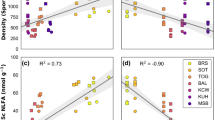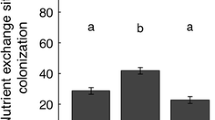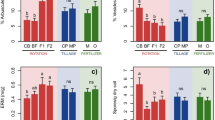Abstract
We tested the prediction that abundance and composition of arbuscular mycorrhizal fungi (AMF) in Ipomopsis aggregata roots and soils are influenced by ungulate herbivory and drought conditions by examining the effects in a field setting over two years. We used a multi-metric approach to quantify AMF root colonization, AMF reproduction, and AMF community composition in roots and soils. We incorporated complimentary community characterization assays by morphologically identifying spores from trap cultures and the use of terminal restriction fragment length polymorphism (T-RFLP) fingerprinting. Herbivory caused a twofold increase in spore production, an increase in AMF taxa diversity in roots, and a shift in AMF species composition in rhizosphere soils. The impact of herbivory was dependent on water availability, which differed in the two contrasting years. This study demonstrates that both soil water availability and herbivory shape arbuscular mycorrhizal fungi communities. The changes to mycorrhizal communities may help in understanding mycorrhizal function in changing climates.





Similar content being viewed by others
References
Tedersoo L, Bahram M, Zobel M (2020) How mycorrhizal associations drive plant population and community biology. Science 367(6480):eaba1223. https://doi.org/10.1126/science.aba1223
Riling MC (2004) Arbuscular mycorrhizae and terrestrial ecosystem processes. Ecol Let 7:740–754. https://doi.org/10.1111/j.1461-0248.2004.00620.x
Bardgett RD, Mommer L, De Vries FT (2014) Going underground: root traits as drivers of ecosystem processes. Trends Ecol Evol 29:692–699. https://doi.org/10.1016/j.tree.2014.10.006
Martínez-García LB, De Deyn GB, Pugnaire FI, Kothamasi D, van der Heijden MGA (2017) Symbiotic soil fungi enhance ecosystem resilience to climate change. Global Change Biol 23:5228–5236. https://doi.org/10.1111/gcb.13785
Mohan JE, Cowden CC, Baas P et al (2014) Mycorrhizal fungi mediation of terrestrial ecosystem responses to global change: mini-review. Fungal Ecol 10:3–19. https://doi.org/10.1016/j.funeco.2014.01.005
Smith SE, Read DJ (2008) Mycorrhizal symbiosis 3. New York: Academic Press
Johnson NC, Graham JH, Smith FA (1997) Functioning of mycorrhizal associations along the mutualism-parasitism continuum. New Phytol 135:575–585. https://doi.org/10.1046/j.1469-8137.1997.00729.x
Hoeksema JD, Chaudhary VB, Gehring CA et al (2010) A meta-analysis of context-dependency in plant response to inoculation with mycorrhizal fungi. Ecol Lett 13:394–407. https://doi.org/10.1111/j.1461-0248.2009.01430.x
Eom AH, Wilson GWT, Hartnett DC (2001) Effects of ungulate grazers on arbuscular mycorrhizal symbiosis and fungal community structure in tallgrass prairie. Mycologia 93:233–242. https://doi.org/10.2307/3761643
Millar NS, Bennett AE (2016) Stressed out symbiotes: hypotheses for the influence of abiotic stress on arbuscular mycorrhizal fungi. Oecologia 182:625–641. https://doi.org/10.1007/s00442-016-3673-7
Deepika S, Kothamasi D (2015) Soil moisture—a regulator of arbuscular mycorrhizal fungal community assembly and symbiotic phosphorus uptake. Mycorrhiza 25:67–75. https://doi.org/10.1007/s00572-014-0596-1
Hazard C, Gosling P, van der Gast CJ et al (2013) The role of local environment and geographical distance in determining community composition of arbuscular mycorrhizal fungi at the landscape scale. ISME 7:498–508. https://doi.org/10.1038/ismej.2012.127
Gehring CA, Whitham TG (1994) Interactions between aboveground herbivores and the mycorrhizal mutualists of plants. Trends Ecol Evol 9:251–255. https://doi.org/10.1016/0169-5347(94)90290-9
Klironomos JN, McCune J, Moutoglis P (2004) Species of arbuscular mycorrhizal fungi affect mycorrhizal responses to simulated herbivory. Appl Soil Ecol 26:133–141. https://doi.org/10.1016/j.apsoil.2003.11.001
Saravesi K, Ruotsalainen AL, Cahill JF (2014) Contrasting impacts of defoliation on root colonization by arbuscular mycorrhizal and dark septate endophytic fungi of Medicago sativa. Mycorrhiza 24:239–245. https://doi.org/10.1007/s00572-013-0536-5
Saikkonen K, Ahonen-Jonnarth U, Markkola AM et al (1999) Defoliation and mycorrhizal symbiosis: a functional balance between carbon sources and below-ground sinks. Ecol Lett 2:19–26. https://doi.org/10.1046/j.1461-0248.1999.21042.x
Barto EK, Rillig MC (2010) Does herbivory really suppress mycorrhiza? A meta-analysis. J Ecol 98:745–753. https://doi.org/10.1111/j.1365-2745.2010.01658.x
Yang W, Zheng Y, Gao C et al (2013) The arbuscular mycorrhizal fungal community responses to warming and grazing differs between soil and roots on the Qinghai-Tibetan Plateau. PLoS ONE 8:e76447. https://doi.org/10.1371/journal.pone.0076447
Murray TR, Frank DA, Gehring CA (2010) Ungulate and topographic control of arbuscular mycorrhizal fungal spore community composition in a temperate grassland. Ecology 91:815–827. https://doi.org/10.1890/09-0209.1
Ba L, Ning J, Wang D et al (2012) The relationship between the diversity of arbuscular mycorrhizal fungi and grazing in a meadow steppe. Plant Soil 352:143–156. https://doi.org/10.1007/s11104-011-0985-6
van der Heyde M, Bennett JA, Pither J, Hart M (2017) Longterm effects of grazing on arbuscular mycorrhizal fungi. Agric Ecosyst Environ 243:27–33. https://doi.org/10.1016/j.agee.2017.04.003
Gehring CA, Whitham TG (2003) Mycorrhizae-herbivore interactions: population and community consequences. In Mycorrhizal Ecology. Berlin Heidelberg: Springer-Verlag
Cotton TE (2018) Arbuscular mycorrhizal fungal communities and global change: an uncertain future. FEMS Microbiol Ecol 94:1–14. https://doi.org/10.1093/femsec/fiy179
Bennett AE, Classen AT (2020) Climate change influences mycorrhizal fungal-plant interactions, but conclusions are limited by geographical study bias. Ecology 101:e02978. https://doi.org/10.1002/ecy.2978
Augé RM (2004) Arbuscular mycorrhizae and soil/plant water relations. Can J Soil Sci 84(4):373–381. https://doi.org/10.4141/S04-002
Weber SE, Diez JM, Andrews LV et al (2019) Responses of arbuscular mycorrhizal fungi to coinciding global change multiple drivers. Fungal Ecol 40:62–71. https://doi.org/10.1016/j.funeco.2018.11.008
Gao C, Kim Y-C, Zheng Y et al (2016) Increased precipitation, rather than warming, exerts a strong influence on arbuscular mycorrhizal fungal community in a semiarid steppe ecosystem. Botany 94:459–460. https://doi.org/10.1139/cjb-2015-0210
Chen YL, Xu ZW, Xu TL et al (2017) Nitrogen deposition and precipitation induced phylogenetic clustering of arbuscular mycorrhizal fungal communities. Soil Biol Biochem 115:233–242. https://doi.org/10.1016/j.soilbio.2017.08.024
Stevens BM, Propster JR, Öpik M et al (2020) Arbuscular mycorrhizal fungi in roots and soil respond differently to biotic and abiotic factors in the Serengeti. Mycorrhiza 30:79–95. https://doi.org/10.1007/s00572-020-00931-5
Wagg C, Jansa J, Stadle M et al (2011) Mycorrhizal fungal identity and diversity relaxes plant–plant competition. Ecology 92:1303–1313. https://doi.org/10.1890/10-1915.1
Powell JR, Parrent JL, Hart MM et al (2009) Phylogenetic trait conservatism and the evolution of functional trade-offs in arbuscular mycorrhizal fungi. Proc Royal Soc B 276:4237–4245. https://doi.org/10.1098/rspb.2009.1015
Kiers TE, Duhamel M, Beesetty Y et al (2011) Reciprocal rewards stabilize cooperation in the mycorrhizal symbiosis. Science 333:880–882. https://doi.org/10.1126/science.1208473
Sendek A, Karakoc C, Wagg C et al (2019) Drought modulates interactions between arbuscular mycorrhizal fungal diversity and barley genotype diversity. Sci Rep 9:9650. https://doi.org/10.1038/s41598-019-45702-1
Furze JR, Martin AR, Nasielski J et al (2017) Resistance and resilience of root fungal communities to water limitation in a temperate agroecosystem. Ecol Evol 7:3443–3454. https://doi.org/10.1002/ece3.2900
Deveautour C, Donn S, Power SA et al (2018) Experimentally altered rainfall regimes and host root traits affect grassland arbuscular mycorrhizal fungal communities. Mol Ecol 27:2152–2163. https://doi.org/10.1111/mec.14536
Chagnon PL, Bradley RL, Maherali H, Klironomos JN (2013) A trait-based framework to understand life history of mycorrhizal fungi. Trends Plant Sci 18(9):484–491. https://doi.org/10.1016/j.tplants.2013.05.001
Frank DA, Gehring CA, Machut L, Phillips M (2003) Soil community composition and the regulation of grazed temperate grassland. Oecologia 137:603–609. https://doi.org/10.1007/s00442-003-1385-2
Hart MM, Reader RJ (2002) Host plant benefit from the association with arbuscular mycorrhizal fungi: variation due to differences in size of mycelium. Biol Fertil Soils 36:357–366. https://doi.org/10.1007/s00374-002-0539-4
Maherali H, Klironmos JN (2007) Influence of phylogeny of fungal community assembly and ecosystem functioning. Science 316:1746–1748. https://doi.org/10.1126/science.1143082
Veresoglou SD, Caruso T, Riling MC (2013) Modeling the environmental and soil factors that shape the niches of two common arbuscular mycorrhizal fungal families. Plant Soil 368:507–518. https://doi.org/10.1007/s11104-012-1531-x
Lerat S, Lapointe L, Gutjahr S et al (2003) Carbon partitioning in a split-root system of arbuscular mycorrhizal plants is fungal and plant species dependent. New Phytol 157:589–595. https://doi.org/10.1046/j.1469-8137.2003.00691.x
Antunes PM, Koch AM, Morton JB et al (2011) Evidence for functional divergence in arbuscular mycorrhizal fungi from contrasting climatic origins. New Phytol 189:507–514. https://doi.org/10.1111/j.1469-8137.2010.03480.x
Allsup C, Paige K (2016) Belowground fungal associations and water interact to influence the compensatory response of Ipomopsis aggregata. Oecologia 180:463–474. https://doi.org/10.1007/s00442-015-3470-8
NOAA National Oceanic and Atmospheric National Weather Service station at Pulliam Airport Flagstaff, Az
PRISM Climate Group, Oregon State University, http://prism.oregonstate.edu, created June 2021
USDA Plant Database
McGonigle TP, Miller MH, Evans DG et al (1990) A new method which gives an objective measure of colonization of roots by vesicular-arbuscular mycorrhizal fungi. New Phytol 115:495–501. https://doi.org/10.1111/j.1469-8137.1990.tb00476.x
INVAM International Culture Collection of (Vesicular) Arbuscular Mycorrhizal Fungi. https://invam.wvu.edu
Lee J, Lee S, Young JPW (2008) Improved PCR primers for the detection and identification of arbuscular mycorrhizal fungi. FEMS Microbiol Ecol 65:339–349. https://doi.org/10.1111/j.1574-6941.2008.00531.x
Lankau RA, Nordurft RN (2013) An exotic invader drives the evolution of plant traits that determine mycorrhizal fungal diversity in a native competitor. Mol Ecol 22:5472–5485. https://doi.org/10.1111/mec.12484
White TJ, Bruns T, Lee S, Taylor JW (1990) Amplification and direct sequencing of fungal ribosomal RNA genes for phylogenetics. In: PCR Protocols: A guide to methods and Applications (315–325) New York: Academic Press Inc
McKenney MC, Lindsey DL (1987) Improved method for quantifying endomycorrhizal fungi spores from soil. Mycologia 79(5):779–782. https://doi.org/10.2307/3807830
R 3.0.1 Core Development Team (2013) R: A language and environment for statistical computing. Vienna: R. Foundation for Statistical Computing
Nishida T, Izumi N, Katayama N, Ohgushi T (2009) Short-term response of arbuscular mycorrhizal associations to spider mite herbivory. Popul Ecol 51:329–334. https://doi.org/10.1007/s10144-008-0116-2
Bever J (2002) Negative feedbacks within a mutualism: host-specific growth of mycorrhizal fungi reduces plant benefit. Proc Royal Soc B 269:2595–2601. https://doi.org/10.1098/rspb.2002.2162
Acknowledgements
We thank Carol Augspurger, Andrew Miller, Victoria Borowicz, Emily Wheeler Lankau, and Sara Paver for their comments on the manuscript. We thank Kelly Allsup, Karlton Allsup and Denise Paige for their help in the field.
Funding
Funding for this project was provided for Cassandra Allsup by summer research fellowship through the Program for Ecology, Evolution, and Conservation Biology at the University of Illinois and NSF Grants 0092554 and 1146085 to Ken Paige.
Author information
Authors and Affiliations
Contributions
CMA, RAL, KNP conceived and designed experiment. CMA and KNP conducted the fieldwork. CMA and RAL collected and analyzed the data. CMA, RAL, and KNP wrote the manuscript.
Corresponding author
Ethics declarations
Conflict of interest
The authors declare no competing interests.
Supplementary Information
Below is the link to the electronic supplementary material.
Rights and permissions
About this article
Cite this article
Allsup, C.M., Lankau, R.A. & Paige, K.N. Herbivory and Soil Water Availability Induce Changes in Arbuscular Mycorrhizal Fungal Abundance and Composition. Microb Ecol 84, 141–152 (2022). https://doi.org/10.1007/s00248-021-01835-3
Received:
Accepted:
Published:
Issue Date:
DOI: https://doi.org/10.1007/s00248-021-01835-3




